油橄榄(Olea europaea L.)隶属于木犀科的木樨榄属,是一种原生于地中海区域的常绿乔木,被列为全球四大木本食用油作物之一,因其所产橄榄油富含营养及多种生物活性成分而广受欢迎[1-3]。自20世纪50年代中国开始引种油橄榄至今,已成功栽培了超过160 个品种[4]。甘肃省陇南地区是中国油橄榄的主要适生区,种植面积达69 926.67 hm2,约占全国种植总面积的55%[5]。然而,陇南油橄榄产业发展受限于品种混杂、老化等问题[6]。保护种质资源多样性是油橄榄新品种选育和产业可持续发展的重要基础。陇南油橄榄国家林木种质资源库通过系统收集国内外优质种质资源,现已整合174份涵盖c从国外引进品种和国内选育品种的遗传材料。当前产业发展的关键在于如何通过系统鉴定与科学评价体系,对种质资源的生物学特性、经济性状及抗逆性等关键指标进行深度解析,进而筛选出具有特异性状的优良种质,为产业发展注入新的活力。因此,如何有效评价和利用这些资源仍是亟待解决的关键问题,而开展种质资源的系统鉴定与科学评价研究,对推动油橄榄产业健康发展具有重要战略意义。
植物表型性状的可塑性是遗传与环境因素相互作用的结果,是生物多样性研究的重要内容。表型多样性不仅反映了物种内部的遗传变异,也是物种适应环境变化的关键[7-8]。遗传多样性作为生物多样性的核心,其变异从基因延伸至细胞功能与生理生化特征,是维系物种生存进化及生态系统稳定的基础[9]。植物表型多样性通过检测叶片形态、开花物候期等性状,解析种群遗传结构与空间变异规律,为揭示其形成机制提供依据[10]。在油橄榄的表型特征遗传多样性方面,相关的分析与评估工作已取得了一定的进展。Sebastiani等[11]认为油橄榄的叶片和果实特性可用于评估不同品种之间的差异。Мousavi等[12]研究表明,油橄榄的果实和油脂特性在不同环境下表现出可塑性,这意味着其表型性状受环境因素影响。徐梁等[13]对浙江省3个油橄榄主栽品种的果实表型与品质性状进行分析,发现果实表型性状间和品质性状间存在显著相关性。孙文勇等[14]发现十堰市引种栽培的6个不同油橄榄品种的叶片及果实表型性状存在显著差异。油橄榄的遗传多样性分析不仅有助于品种鉴定和分类,还可以应用于育种计划,以提高油橄榄的产量和油脂质量[11]。通过分析油橄榄的表型和遗传特性,可以更好地理解其对环境变化的适应性,这对油橄榄的栽培和改良具有重要意义[12]。
丰富的种质资源是选育优良品种的基础,对油橄榄种质资源叶形和果形表型性状进行系统的鉴定与评价,有助于充分挖掘陇南油橄榄优异种质资源。笔者在本研究中对甘肃陇南国家油橄榄种质资源库引进的98 份油橄榄种质资源的果实及叶片等14 个表型性状进行了遗传多样性分析。采用多重比较、变异分析、相关性分析、主成分分析及聚类分析等统计手段,并结合变异系数与香农-维纳多样性指数,对油橄榄的叶片和果实进行了全面的表型特征鉴定与综合评估,旨在揭示油橄榄不同品种果实及叶片性状的变异特点和遗传多样性,以期为油橄榄后续引种、新品种选育及优异性状的全基因组关联分析等提供基础依据。
1 材料和方法
1.1 试验地概况
试验基地位于甘肃省陇南市武都区的白龙江河谷两侧,地理位置为北纬33°24'、东经104°55',地处海拔1079 m。年平均气温适宜,达到14.2 ℃,且年均日照时长充足,为1 560.4 h。最高气温极端值可达到35.6 ℃,而最低气温极端值则可降至-8.1 ℃。该地区的年平均降水量约551.2 mm,且相对湿度保持在61%左右。
1.2 试验材料
2023—2024 年在甘肃省林科院油橄榄种质资源收集区采集试验材料。参与试验的98 份种质资源包括来源于意大利、西班牙、希腊、土耳其、法国、苏联、阿尔及利亚等国家的品种,以及国内选育的品种、品系和优株(表1)。于2019 年春季统一嫁接于“城固18 a”的砧木上。所有树体的长势、立地条件以及水肥等栽植管理措施一致。
表1 供试油橄榄种质材料信息
Table 1 Testing information of olive germplasm

编号No.3-23 1-10 8-66 7-57 8-80 8-71 4-29 8-67 10-109 11-65 2-16 2-18 1-2 3-22 1-7 5-33 9-103 8-95 11-2 8-61 10-120 10-125 9-90 8-81 8-73 9-94 8-64 10-104 10-107 10-117 1-8 10-116 8-72 8-69 8-77 1-1 7-55 10-106 6-49 6-45 4-30 5-34 2-15 1-4 10-129 10-130 9-87 7-56 7-51种名Species name Chond绿源小苹果Lüyuan-Мanzanlla小苹果Мanzanlla卡斯套终Borriol De Castellon-17 Avtoxn切姆拉尔Chemlal de kabylie格洛桑Grossane奥托卡Ottobratica城固47 Chenggu-47科拉蒂Coratina坦彩Tanche卡拉蒙Kalamon М2盖多瑞利雅Gaidourelia云杂3 YunZ-3马托迪Мastoidis西阿基Thiaki拉多利亚ⅡLadolia Ⅱ莱星Leccino戈达尔Cordal九峰7号Jiufeng-7杂-2 Za-2希腊-3 Greece-3米提尼Adramittini卡林Kallniot(G)拉多利亚I LadoliaI恩帕特雷Empeltre瓦拉Valanolia城固31 Chenggu-31海口优-2 Haikouyou-2绿源-1 Lüyuan-1海口优-1 Haikouyou-1爱桑Elbasan(Y)贝拉Berat白橄榄Ulliri Bardhe М1阿尔波萨娜Arbosana克里172 Crimean-172莫拉约罗Мoraiolo佛奥17 Frantoio-17胡耶特Verdaledel Hérault沙龙奎Salonenque格里昂Grignan М4库2 K2库3 K3 FS17岚桂塔Blanqueta配多灵Pendolino采集地Collection places中国China中国China西班牙Spain西班牙Spain希腊Greece阿尔及利亚Algeria法国France意大利Italy中国China意大利Italy法国France希腊Greece中国China希腊Greece中国China希腊Greece希腊Greece希腊Greece意大利Italy西班牙Spain中国China中国China希腊Greece希腊Greece阿尔巴尼亚Albania希腊Greece西班牙Spain希腊Greece中国China中国China中国China中国China阿尔巴尼亚Albania阿尔巴尼亚Albania阿尔及利亚Algeria中国China西班牙Spain苏联Soviet Union意大利Italy意大利Italy法国France法国France意大利Italy中国China中国China中国China希腊Greece西班牙Spain意大利Italy编号No.8-84 9-92 10-118 6-36 1-5 10-115 8-82 8-79 10-113 10-119 4-26 10-123 8-83 2-14 1-6 6-42 6-43 6-41 2-12 9-102 9-98 10-128 8-78 10-124 10-112 8-68 9-86 1-3 4-28 6-44 1-11 10-121 7-52 8-62 9-93 3-21 8-76 10-108 4-25 6-37 3-20 2-17 6-35 5-32 10-126 8-65 8-85 10-110 10-122种名Species name边克丽娜Biancolilla孔色维拉Konservolia会理-X Huili-X软阿斯Ascolano Tenera云杂1 YunZ-1鄂植8号EZ-8阿托斯Agiou orous尼2N2 D-16九峰6号Jiufeng-6豆果Arbequina玉蝉-44 Yuchan-44阿果拉Amyglalolia格里莎Gorossanne云杂2 YunZ-2科拉蒂Coratina德里达Dritta切姆拉里Chemlal苏里Soury Sevillano①美加里基Мegaritiki库1 K1小尼Nikiskii云台YunTai D-133皮瓜尔Picual法加Farga М3科佛奥Frantoio Corsini佛奥Frantoio涛源Taoyuan N-79皮削利Picholine Languedoc科尼卡Cornicabra柯基Koroneiki豆果优Arbequina-S西格伊司27 Seeger Ismail-27城固32 Chenggu-32马纳凯Amasnaki科尼诺Canino Kou-t Koutsourelia沃丽Rosciola坦彩Tanche卢克斯Lucques玉蝉Yuchan贺吉布兰克Hojiblanca超克Chalkidikis城固51 Chenggu-51沃丽Rosciola采集地Collection places希腊Greece希腊Greece中国China意大利Italy中国China中国China希腊Greece苏联Soviet Union中国China中国China西班牙Spain中国China希腊Greece未知Unknown中国China意大利Italy意大利Italy突尼斯Tunisia黎巴嫩Lebanon未知Unknown希腊Greece中国China苏联Soviet Union中国China中国China西班牙Spain西班牙Spain中国China法国France意大利Italy中国China未知Unknown法国France西班牙Spain希腊Greece西班牙Spain阿尔及利亚Algeria中国China法国France意大利Italy希腊Greece意大利Italy法国France法国France中国China中国China希腊Greece中国China意大利Italy
1.3 测定指标及方法
1.3.1 叶片性状测定 叶片性状测定采用分层随机抽样法,每个品种选取3 株健壮成年植株,于树冠东、南、西、北4方位各采集1条中部一年生健康枝条(距地面1.2~1.8 m),每枝条选取第4~6 节位5 枚健康叶片。使用游标卡尺、数显千分尺及厚度计分别测定纵径、横径、叶间距和叶片厚度,计算叶形指数。
1.3.2 果实性状测定 在果实生理成熟期,每个样株选取3株生长基本一致的结果树作为调查对象,在树冠外围东、南、西、北4个方向随机选取健康、无病虫害的果实,每株采摘30个,每个品种采集90个果实,采摘后混合,密封保鲜。用精度0.01 mm电子显示游标卡尺测定果实纵径、果实横径、果核纵径、果核横径、果肉厚度,用精度0.01 g的电子天平称量单果质量和果核质量,计算果形指数、果核指数和果肉率。
1.4 数据分析
使用Мicrosoft Excel 2019软件进行数据统计和处理。变异系数(Coefficient of Variation,CV)计算公式为CV/%=(标准差/平均值)×100[15]。香农指数(Shannon's Index,H′ )计 算 公 式 为 H′ =![]() [16]。采用主成分分析(Principal Component Analysis,PCA)将高维数据集转换为较低维度的数据[17]。通过SPSS26.0 以平方欧式距离计算98份种质资源数量型性状遗传距离,利用МEGAX 软件按UPGМA遗传距离进行聚类分析并绘制聚类图以确定种质资源的分类[18]。
[16]。采用主成分分析(Principal Component Analysis,PCA)将高维数据集转换为较低维度的数据[17]。通过SPSS26.0 以平方欧式距离计算98份种质资源数量型性状遗传距离,利用МEGAX 软件按UPGМA遗传距离进行聚类分析并绘制聚类图以确定种质资源的分类[18]。
2 结果与分析
2.1 油橄榄种质资源叶片表型性状多样性分析
油橄榄种质资源叶片典型形态特征见图1。通过分析发现叶片先端形状、叶基形状和叶片纵向弯曲方向的变异系数均在30%以上,而叶片形状的变异系数仅为14.88%(表2)。进一步分析发现,在4种叶片形状类型中,98 份种质资源多为椭圆披针形,占90.82%,椭圆形次之,为7.14%,披针形和卵圆形极少,仅为2.04%。在叶片先端形状的4 种类型中,频率分布较为均匀,其中渐尖和尖分别占14.20%和48.90%,凸尖和圆钝均占18.30%。在4种叶基形状中,狭楔形和楔形较为普遍,狭楔形略少于楔形,两者占94.80%;阔楔形极少,仅占5.10%。叶片纵向弯曲方向的频率分布显示向上弯曲和平直较多,占82.50%,扭曲最少,仅占2.00%。
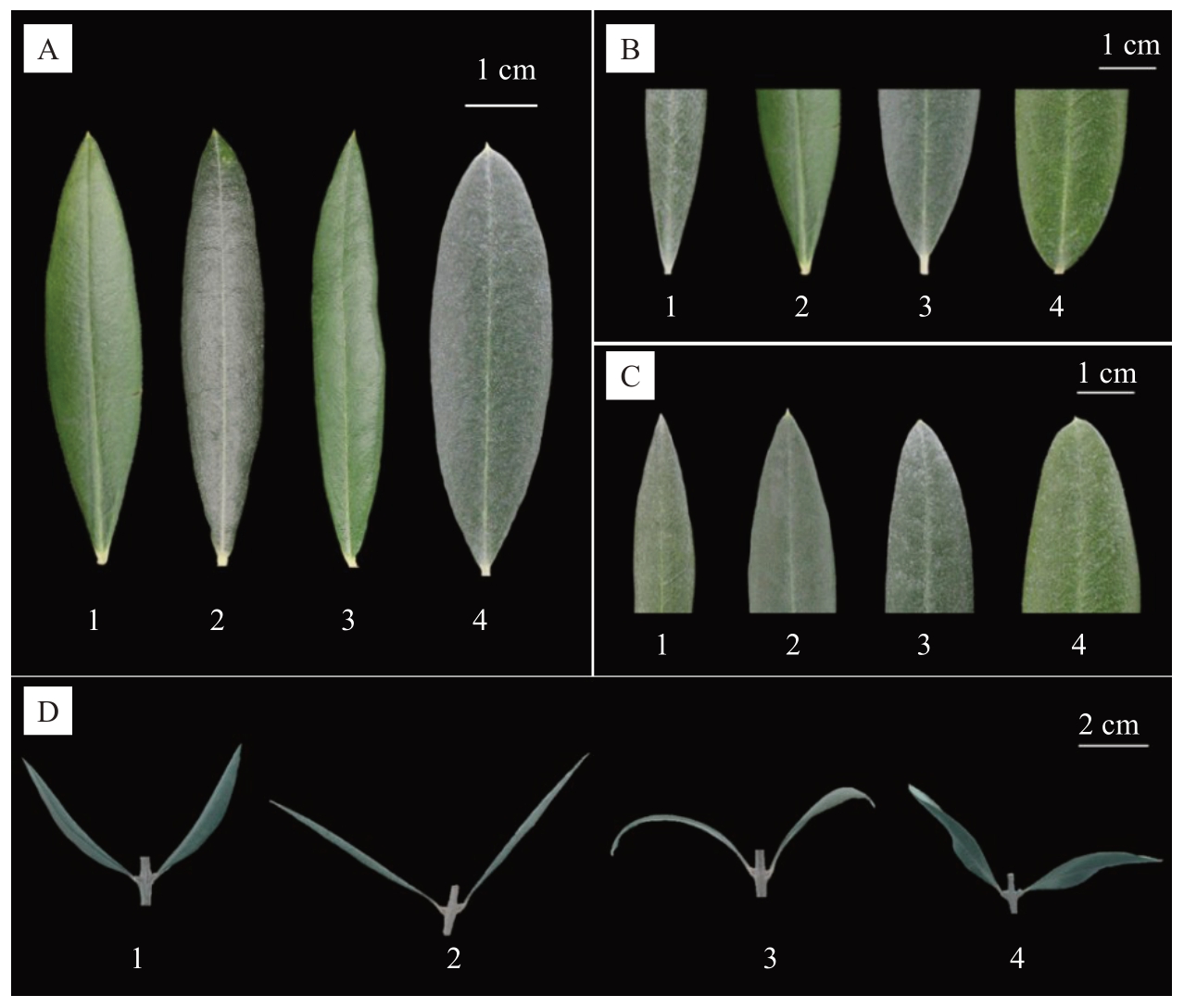
图1 油橄榄叶片质量性状特征
Fig.1 Quality traits of olive leaf morphology
A.叶片形状。1.椭圆形(豆果);2.椭圆披针形(米提尼);3.披针形(贝拉);4.卵圆形(Psylia)。B.叶基形状。1.狭楔形(科尼诺);2.楔形(豆果);3.阔楔形(Psylia);4.圆弧形(超克)。C.先端形状。1.渐尖(阿托斯);2.尖(涛源);3.凸尖(D-16);4.圆钝(超克)。D.叶片弯曲形状。1.向上弯曲(沃丽);2.平直(马纳凯);3.向下弯曲(格里莎);4.扭曲(尼2)。
A.Leaf shape.1.Elliptical(Arbequina);2.Elliptical-lanceolate(Adramittini);3.Lanceolate(Berat);4.Ovate(Psylia).B.Leaf base shape.1.Narrowly cuneate (Canino); 2. Cuneate (Arbequina); 3. Broadly cuneate (Psylia); 4. Arcuate (Chalkidikis). C. Leaf apex shape. 1. Acuminate (Agiou orous); 2. Sharp (Tao Yuan); 3.Acuminate (D-16); 4. Obtuse (Chalkidikis). D. Leaf curvature shape. 1. Upwardly curved (Rosciola); 2. Flat (Мanaki);3.Downwardly curved(Gorossanne);4.Twisted(N2).
表2 油橄榄种质资源叶片质量性状频率分布及多样性
Table 2 Frequency distribution and diversity of quality traits in olive germplasm resources leaves

质量性状Leaf quality trait叶片形状Leaf shape先端形状Shape of leaf apex叶基形状Shape of leaf base叶片纵向弯曲方向Blade bends longitudinally平均Мean代码Code LS LAS LBS BBL频率Frequency/%1 7.14 14.20 39.70 44.80 2 3 4 90.82 48.90 55.10 37.70 2.04 18.30 5.10 15.30 0.00 18.30 0.00 2.00变异系数Coefficient of variation,CV/%14.88 57.79 34.86 48.61 39.04多样性指数Shannon-Wiener(H′)4.68 4.66 4.82 4.72 4.72
由表3可知,油橄榄种质资源叶片的5个数量性状变异系数介于13.69%~18.43%。在5 个叶片外观形态性状中,叶间距的变异系数最大,为18.43%,变异幅度为11.84~35.65 mm,而叶长的变异系数最小,为13.69%,变异幅度为42.25~87.06 mm。这表明叶长性状更为稳定。
表3 油橄榄种质资源叶片数量性状变异
Table 3 Variation in leaf quantity traits of olive germplasm resources

数量性状Quantitative trait叶长Leaf length/mm叶宽Leaf width/mm叶形指数Leaf Shape Index叶厚Leaf thickness/mm叶间距Leaf Spacing/mm平均Мean代码Code LL LW LILTID均值±标准差x±s 56.11±7.68 11.82±1.88 4.82±0.72 0.37±0.07 21.34±3.93中位数Мedian 54.84 11.87 4.80 0.36 21.10极大值Мax.87.06 18.38 6.86 0.71 35.65极小值Мin.42.25 8.33 3.08 0.24 11.84极差Range 44.81 10.05 3.78 0.47 23.81变异系数Coefficient of variation,CV/%13.69 15.94 14.88 18.09 18.43 16.20多样性指数Shannon-Wiener(H′)4.59 4.61 4.68 5.90 4.59 4.87
油橄榄叶片表型性状的变异离散程度排序显示,叶片的质量性状(平均变异系数为39.04%,表2)相较于外观形态的数量性状(平均变异系数为16.20%,表3)具有更高的变异性。对于5个数量性状而言,其遗传多样性指数(H′)的范围在4.59~5.90之间,平均值为4.87。结合表2和表3的分析结果,叶片外观形态的数量性状遗传多样性指数平均值为4.87,而叶片质量性状则为4.72,表明油橄榄叶片的这两种类型性状在遗传变异上均表现出良好的均匀性。
2.2 油橄榄种质资源果形分类和果形指数分析
如图2 所示,对98 份油橄榄种质的果实形状进行了细致的分类,归纳出10种不同的形态:心形(戈达尔)、弯形(德里达)、卵圆形(海口优2)、倒卵圆形(会理X)、橄榄形(柯基)、圆形(白橄榄)、圆锥形(苏里)、桃形(拉多利亚I)、长椭圆形(钟山24)、椭圆形(卡斯套钟)等,具有丰富的遗传多样性。在鉴定过程中,果实的形状主要依据视觉观察和果形指数来判定。其中,心形、弯形、卵圆形、橄榄形、圆锥形、桃形因其独特的外观特征,可以直观地区分;而倒卵圆形、圆形、椭圆形和长椭圆形则因外观相似,需要借助果形指数进行更精确的区分。
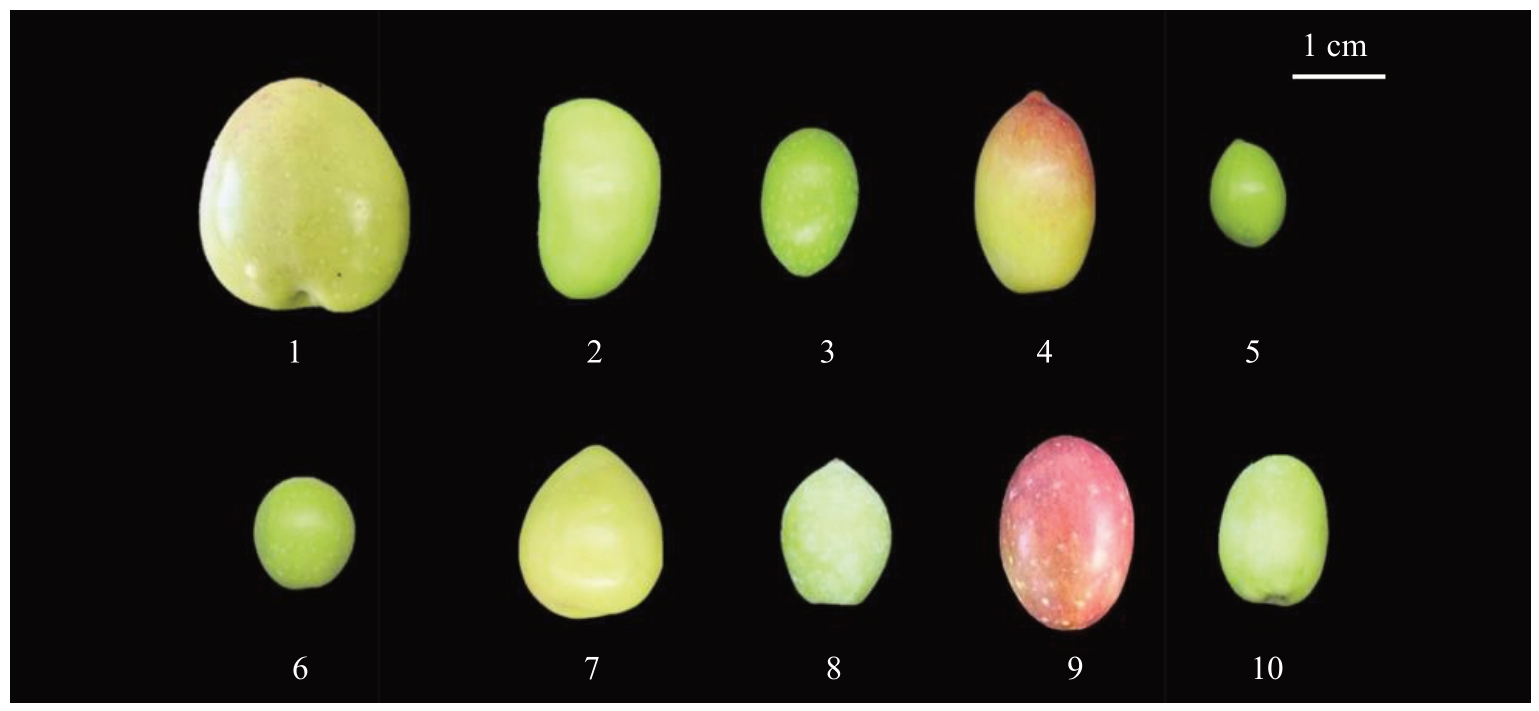
图2 油橄榄果实形状及代表材料
Fig.2 Olive fruit shapes and representative varieties
1.心形(戈达尔);2.弯形(德里达);3.卵圆形(海口优2);4.倒卵圆形(会理X);5.橄榄形(柯基);6.圆形(白橄榄);7.圆锥形(苏里);8.桃形(拉多利亚I);9.长椭圆形(钟山24);10.椭圆形(卡斯套钟)。
1.Heart shape(Cordal);2.Curved(Dritta);3.Ovate(Haikouyou-2);4.Obovate(Huili X);5.Oblate(Koroneiki);6.Round(Ulliri Bardhe);7.Conical(Soury);8.Peach shape(LadoliaI);9.Long oval(Zhongshan-24);10.Broad lipsoid(Borriol De Castellon).
在98份油橄榄种质资源中,椭圆形和长椭圆形果实的类型占比最高,合计44%,其次是圆形,占比12%,倒卵圆形占10%。剩余的34%则由其他形态的果实构成,其中心形和橄榄形较为罕见,各占3%(图3)。总体而言,尽管油橄榄种质的果实形态多样,但圆形、椭圆形和长椭圆形是最为常见的类型,而心形、橄榄形和弯形等较为特殊的形态则相对稀少。
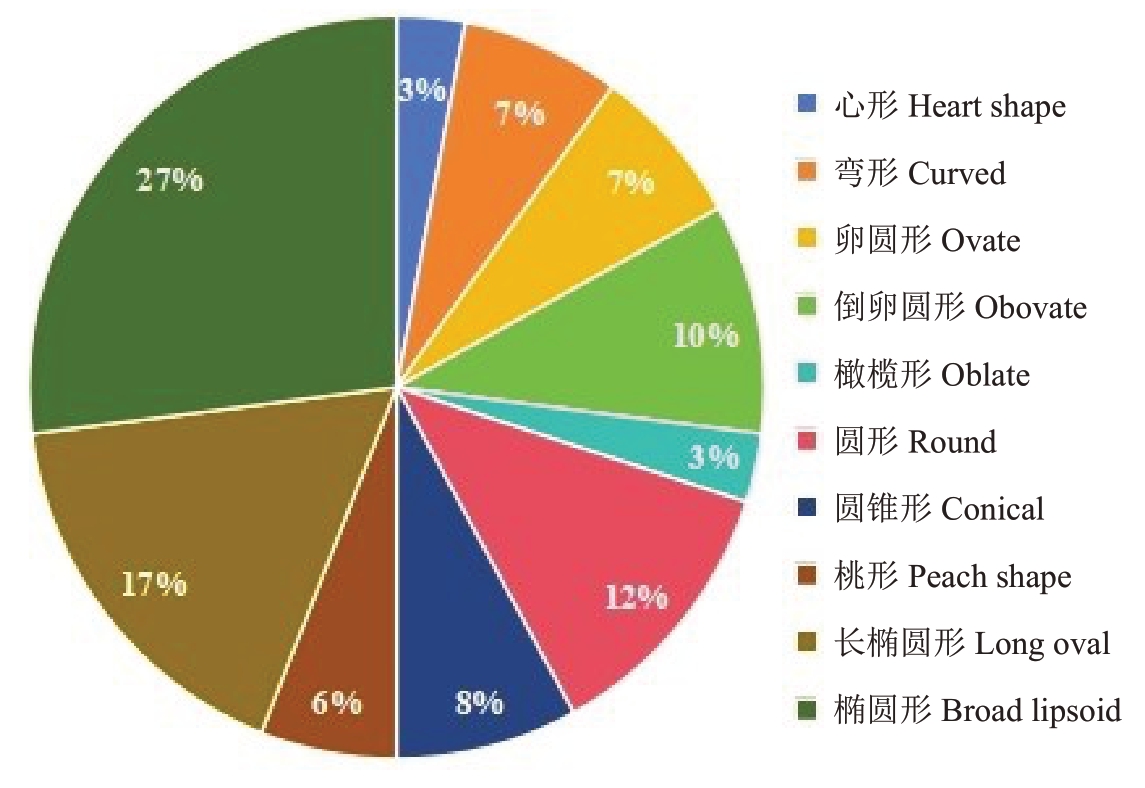
图3 不同品种类型油橄榄果形种质的数量及比例
Fig.3 Number and proportion of olive fruit shape germplasm of different varieties
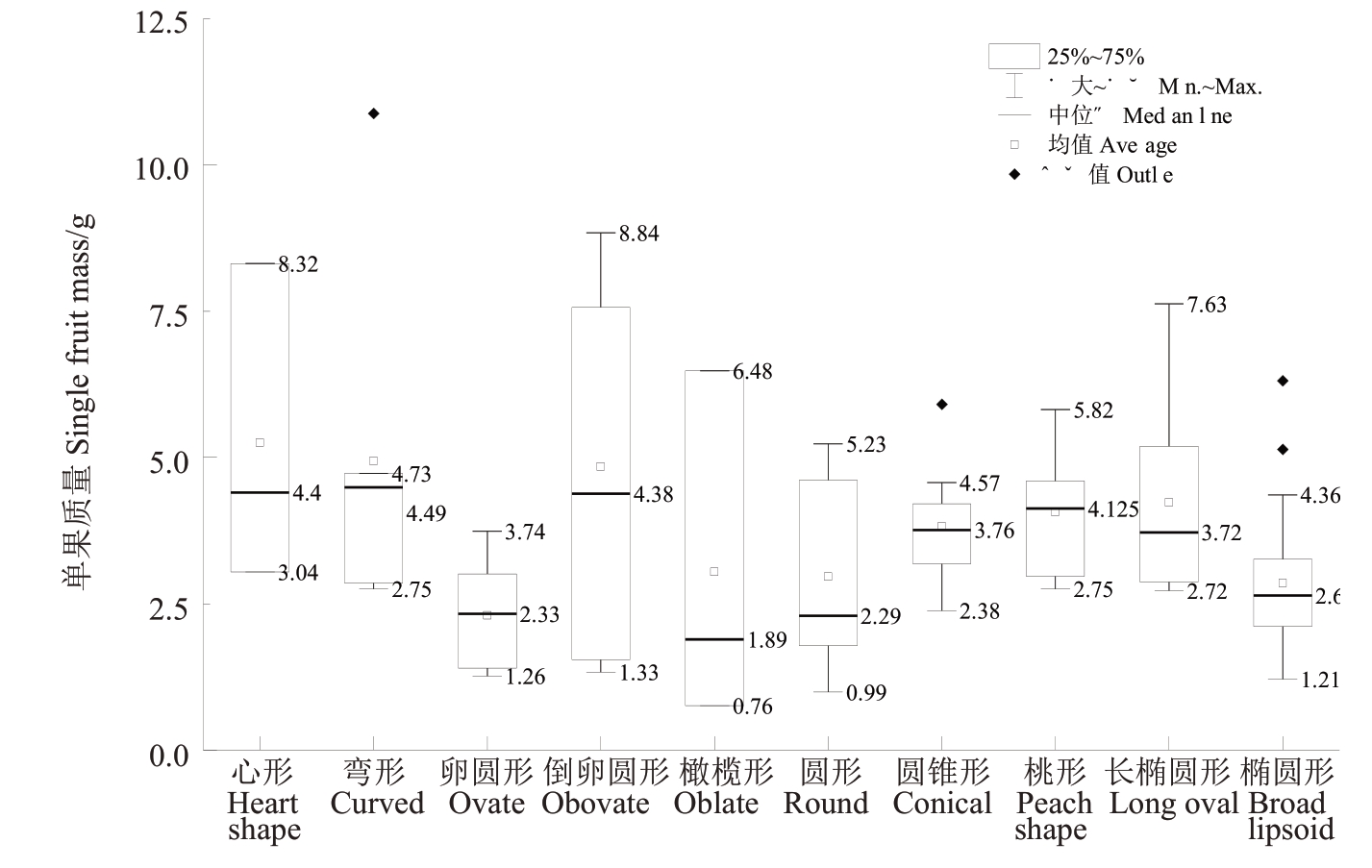
图4 不同果形油橄榄单果质量统计
Fig.4 Statistical analysis of single fruit mass for different olive fruit shapes
2.3 油橄榄种质资源果形与单果质量的相关性分析
对不同果形的油橄榄单果质量进行统计分析(图3~4、表4),不同果形之间差异较大,单果质量平均值最小的为橄榄形(1.89 g),最大的为弯形(4.49 g),且油橄榄果实数量性状的均值和中位数一致,说明果实数量性状检测样品具有稳定性和典型性。油橄榄种质资源的各数量性状表现出显著的变异范围,涵盖了8个表型性状,其变异系数在8.00%~52.29%之间波动,变异幅度较为广泛。特别地,单果质量的变异系数最高,达到了52.29%,相比之下,果肉率的变异系数最低,仅为8.00%。遗传多样性指数范围为4.55~5.38,表明各性状间遗传多样性丰富,且果核质量和果肉率多样性指数较高,分别为5.38 和5.19。遗传多样性指数变化为:果核质量>果肉率>果肉厚>果核横径>果实横径=单果质量>果实纵径>果核纵径。
表4 油橄榄种质资源果实表型性状统计情况
Table 4 Statistical overview of fruit phenotypic traits in olive germplasm resources

数量性状Quantitative trait果实纵径Fruit vertical diameter/mm果实横径Fruit transverse diameter/mm单果质量Single fruit mass/g果肉厚Pulp thick/mm果核纵径Kernel vertical diameter/mm果核横径Kernel transverse diameter/mm果核质量Kernel mass/g果肉率Pulp percentage/%平均Мean最大值Мax.35.68 24.03 10.88 18.26 89.16 27.90 1.16 0.94 26.00最小值Мin.13.58 9.80 0.76 1.79 5.10 5.24 0.20 0.51 4.62中位数Мedian 20.88 15.51 3.15 4.14 14.86 7.65 0.57 0.83 8.45均值±标准差x±s 21.34±4.26 16.05±2.96 3.61±1.89 4.29±1.85 15.73±8.02 7.92±2.38 0.58±0.20 0.82±0.07 8.80变异系数Coefficient of variation,CV/%19.98 18.45 52.29 43.07 50.99 30.01 33.65 8.00 32.06多样性指数Shannon-Wiener(H′)4.59 4.60 4.60 4.63 4.55 4.62 5.38 5.19 4.77
2.4 不同油橄榄种质表型性状的主成分分析
对98 个油橄榄品种的14 个数量型表型特征进行了主成分分析(表5)。根据特征值作为主成分选择的准则,这14个特征可以被归纳为6个主成分,特征值分别达到了4.869、1.949、1.469、1.217、1.318 和1.023,均超越了阈值1。这6个主成分的总贡献率为83.327%,有效地反映了98份油橄榄种质在14个表型特征上的核心信息。第一主成分贡献率为29.589%,特征向量显示,果实纵径、果实横径、果肉厚果肉率具有较高的正载荷,表明这些性状在第一主成分中具有较高的变异性,可以把第一主成分作为果实外观品质和产量的综合指标。第二主成分贡献率为13.737%,特征向量显示,叶长、叶宽和叶形指数具有较高载荷绝对值,反映了叶片形态的主要特征。第三主成分贡献率为11.995%,单果质量和果核横径具有较高的正载荷,反映了果实形状的特征。第四主成分贡献率为11.459%,叶长、叶宽和叶形指数具有较高的正载荷。第五主成分贡献率为8.548%,果核质量具有极高的正载荷,反映了果核的主要特征。第六主成分贡献率为7.998%,叶厚具有极高的正载荷,代表叶片厚度在第六主成分中的显著变异性。
表5 各性状的主成分载荷
Table 5 Factor loading matrix of each trait

特征向量Eigen vector叶长Leaf length叶宽Leaf width叶形指数Leaf shape index叶厚Leaf thickness叶间距Leaf spacing果实纵径Fruit vertical diameter果实横径Fruit transverse diameter单果质量Single fruit mass果肉厚Pulp thick果核纵径Kernel vertical diameter果核横径Kernel transverse diameter果核质量Kernel mass果肉率Pulp percentage特征值Eigenvalue贡献率Contribution rate累计贡献率Cumulative contribution rate主成分Principle factor 1-0.003 0.088-0.105-0.031-0.031 0.232 0.270-0.039 0.267 0.046-0.075 0.032 0.252 4.869 29.589 29.589 2 3 4 5 6 0.221-0.338 0.600 0.029-0.148-0.126-0.041-0.144-0.048 0.091 0.107 0.072-0.172 1.949 13.737 43.326-0.041-0.009-0.026-0.025 0.026 0.137-0.166 0.493-0.111 0.277 0.487-0.078 0.022 1.469 11.995 55.321 0.662 0.314 0.262-0.063 0.176 0.034-0.010 0.064 0.060-0.138-0.076-0.009-0.032 1.217 11.459 66.780-0.008-0.032 0.044 0.034-0.053-0.027 0.025-0.063-0.055 0.006 0.019 0.766 0.199 1.318 8.548 75.328-0.042-0.014-0.013 0.785 0.431-0.125-0.005-0.217-0.039 0.139 0.180 0.024-0.014 1.023 7.998 83.327
2.5 基于油橄榄种质表型性状的聚类分析
依据油橄榄14 个表型性状对参试油橄榄种质资源进行聚类分析(图5),将98份种质资源划分为3个类群,各类群的具体性状特征如表6所示。由图5和表6可知,类群I包含23份种质资源,包括盖多瑞利雅、戈达尔、超克和皮瓜尔等种质,其主要特征为果实较大,果肉率(87%)较高。类群Ⅱ包含55份种质资源,包括柯基、沃丽、西阿基和豆果等种质,其主要特征为较大的叶长(59.25 mm)、叶宽(12.24 mm)和较小的单果质量(2.90 g)。类群Ⅲ包含20份种质资源,包括科拉蒂、爱桑和鄂植8 号等种质,其主要特征为具有较大的叶间距和中等的果实大小。
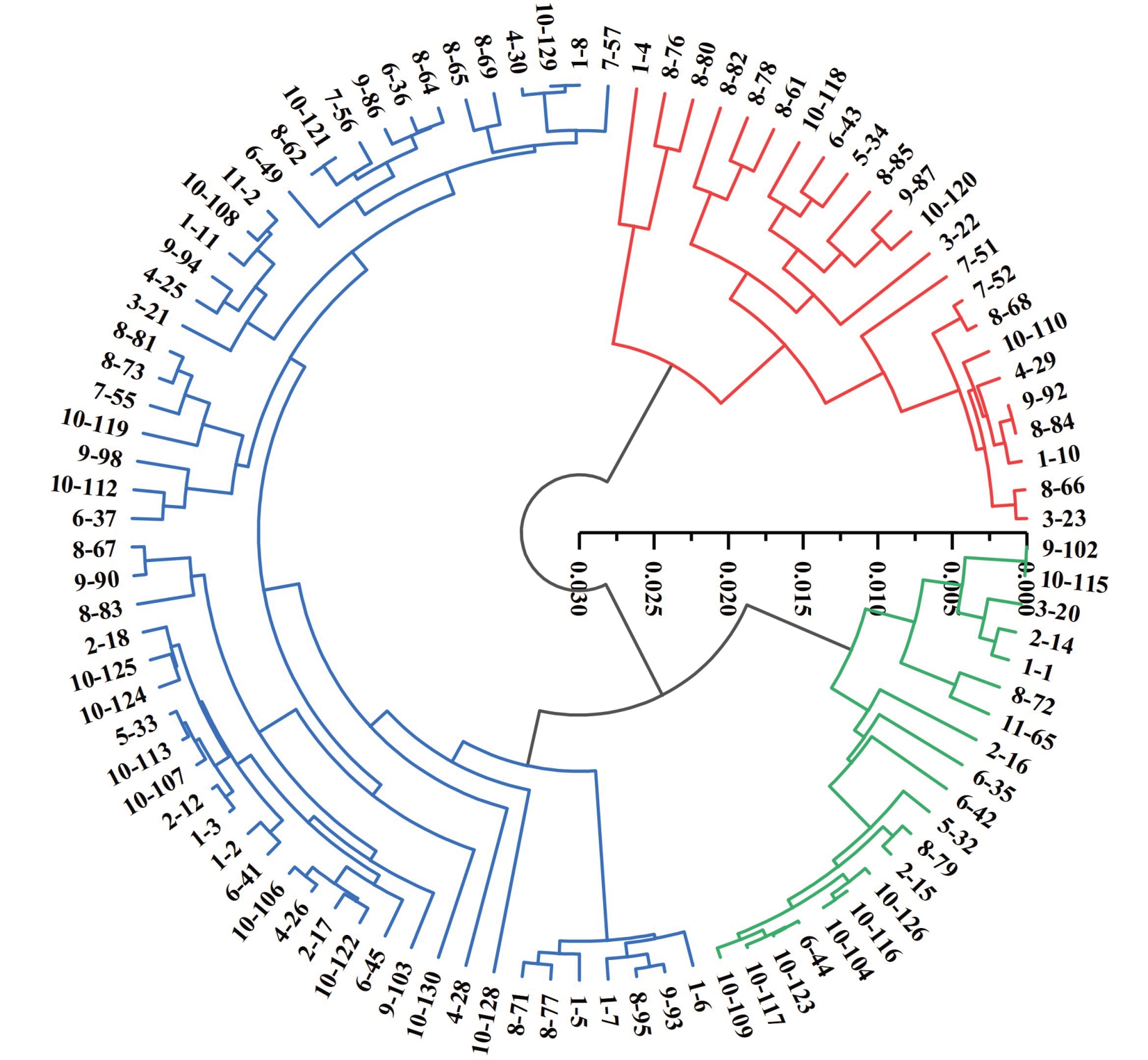
图5 油橄榄种质资源表型性状聚类分析
Fig.5 Cluster analysis of phenotypic traits in olive germplasm resources
表6 不同类群油橄榄果实及叶片表型性状的比较
Table 6 Comparison of phenotypic traits of fruits and leaves in different groups of olive
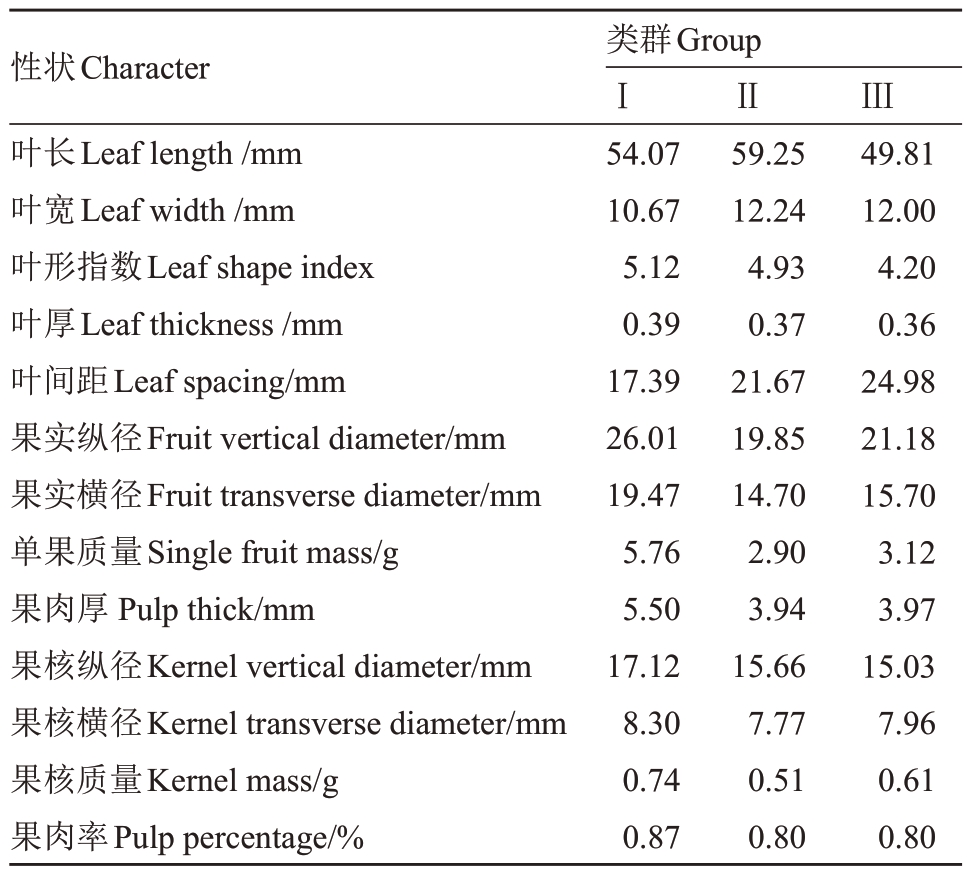
性状Character叶长Leaf length/mm叶宽Leaf width/mm叶形指数Leaf shape index叶厚Leaf thickness/mm叶间距Leaf spacing/mm果实纵径Fruit vertical diameter/mm果实横径Fruit transverse diameter/mm单果质量Single fruit mass/g果肉厚Pulp thick/mm果核纵径Kernel vertical diameter/mm果核横径Kernel transverse diameter/mm果核质量Kernel mass/g果肉率Pulp percentage/%类群GroupI54.07 10.67 5.12 0.39 17.39 26.01 19.47 5.76 5.50 17.12 8.30 0.74 0.87ⅡⅢ59.25 12.24 4.93 0.37 21.67 19.85 14.70 2.90 3.94 15.66 7.77 0.51 0.80 49.81 12.00 4.20 0.36 24.98 21.18 15.70 3.12 3.97 15.03 7.96 0.61 0.80
3 讨 论
变异系数作为表型性状变异的关键衡量标准,与遗传多样性呈正相关,有助于区分植物品种和种质资源,为品种鉴定和种质保护提供有效手段[19]。油橄榄经过长期驯化历史(约6000 年)和广泛的地理分布积累了丰富的遗传多样性[20]。通过对98 份油橄榄种质资源14个表型性状的分析,发现不同油橄榄种质表型差异显著。变异系数均值的范围为8.00%~50.99%,平均为25.96%,与南疆土桃的17.39%~48.49%相近[21],高于苦楝Melia azedarach的19.79%[22]、无患子Sapinndus mukurossi的7.34%[23]和香合欢Albizia odoratissima 的13.08%[24]。说明油橄榄具有较高的适应性和可塑性,可供选择的潜力大。对野生大麦(Hordeum spontaneum)种群的研究表明,自然选择与基因流会通过增加群体内等位基因频率的异质性,导致表型变异系数值升高[25]。油橄榄叶片表型性状变异系数均值为26.35%,果实和种子表型性状变异系数均值为32.06%。综上所述,相对于叶片而言,油橄榄果实和种子的总体指标相对更为稳定,受到环境的影响较小。
油橄榄的表型性状遗传多样性指数(H′)范围为4.55~5.90,平均为4.81,高于杨梅的0.512~1.515[26]和油茶的0.64~0.85[17]。Boucheffa 等[27]研究表明油橄榄种质具有丰富的等位变异和高水平的遗传多样性。油橄榄的遗传多样性指数对育种具有重要影响。遗传多样性是生物种群适应环境变化和生存的基础,对于油橄榄来说,高遗传多样性意味着有更多的基因型可供选择,从而有助于改良和培育出具有优良性状的新品种[28]。对表型性状间的相关性进行分析,有助于评估次要性状对主要性状遗传改进的贡献,从而为育种过程中多个性状的有效筛选提供理论上的指导依据[29]。
聚类分析作为一种有效的统计工具,能够揭示种质资源之间的亲缘关系和遗传差异,为种质资源的分类和选育工作提供科学的方法和依据[30]。笔者在本研究中通过聚类分析将98 份油橄榄种质资源聚为3个类群,每个类群具有独有的特征,这些特征不仅反映了油橄榄的遗传多样性,也为育种和实际应用提供了重要依据。类群I(23 份种质)以果实大(平均单果质量≥5.8 g)、果肉率(≥85%)和含油率(≥22%)显著高于其他类群为特征。在实际应用中,该类群可作为高含油率橄榄油生产的核心亲本,例如通过杂交将大果性状与高含油率结合,培育高产新品种[31]。此外,果肉率高的特性可进一步开发为餐用橄榄加工专用品种,提升产业链附加值。
类群Ⅱ包含55 份种质,特征为叶片较大,单果质量较小。这类种质可能在适应性方面具有优势,可用于研究叶片大小与环境适应性之间的关系,并在育种中用于提高油橄榄的环境适应性。例如,RAZOUK[32]等利用叶片宏观特征对橄榄品种进行耐旱性表型分析,首次提供了关于叶状表型在橄榄抗旱筛选中的应用,为理解叶片性状与环境适应性的关系提供了参考。未来可针对干旱、盐碱等逆境筛选该类群特异表达基因,并结合CRISPR/Cas9 技术精准改良栽培品种的抗逆性[33]。
4 结 论
笔者在本研究中对陇南国家油橄榄种质资源库98份种质资源开展表型分析,揭示其丰富的遗传多样性。通过主成分与聚类分析将种质划分为3个特征类群:类群I果实性状优异(果肉率74.0%),适于高产栽培;类群Ⅱ叶片性状突出(叶形指数4.93),具环境适应潜力;类群Ⅲ叶间距显著(24.98 cm),利于优化树冠结构。研究结果为油橄榄定向育种、栽培模式优化及种质资源高效利用提供了表型特征基础与分类依据。
[1] LUAN F,ZENG J S,YANG Y,HE X R,WANG B J,GAO Y B,ZENG N. Recent advances in Camellia oleifera Abel.:A review of nutritional constituents,biofunctional properties,and potential industrial applications[J].Journal of Functional Foods,2020,75:104242.
[2] 邵文豪.我国油橄榄栽培品种分子鉴定及遗传评价研究[D].北京:中国林业科学研究院,2019.SHAO Wenhao.A study on molecular identification and genetic evaluation of olive cultivars in China[D].Beijing:Chinese Academy of Forestry,2019.
[3] 胡蓉,张茜,陈勃,蒋召雪,陈治光,曲继鹏,丁春邦,佟兆国.油橄榄果实表型性状多样性分析[J].植物资源与环境学报,2024,33(6):83-93.HU Rong,ZHANG Qian,CHEN Bo,JIANG Zhaoxue,CHEN Zhiguang,QU Jipeng,DING Chunbang,TONG Zhaoguo.Analysis on diversity of fruit phenotypic traits of Olea europaea[J].Journal of Plant Resources and Environment,2024,33(6):83-93.
[4] 马婷,王玺,张艳丽,宁德鲁.3 个杂交油橄榄品种实生后代果实性状的多样性分析[J]. 西北林学院学报,2022,37(6):100-106.МA Ting,WANG Xi,ZHANG Yanli,NING Delu. Fruit character diversity analysis of seedling progeny from three hybrid olive varieties[J].Journal of Northwest Forestry University,2022,37(6):100-106.
[5] 中国乡村发展志愿服务促进会.中国油橄榄产业发展蓝皮书2023[М].北京:研究出版社,2024:002-005.China Rural Development Volunteer Service Promotion Association. China Olive Industry Development Blue Book 2023[М].Beijing:Research Publishing House,2024:002-005.
[6] 张正武,周鹏飞,海光辉,杨永兴,巩芳娥.甘肃陇南油橄榄产业发展现状及对策[J].中国果树,2023(6):131-136.ZHANG Zhengwu,ZHOU Pengfei,HAI Guanghui,YANG Yongxing,GONG Fang’e. Development status and countermeasures of olive industry in Longnan,Gansu province[J].China Fruits,2023(6):131-136.
[7] ZHU S L,NIU E L,SHIA N,МOU B Q.Genetic diversity analysis of olive germplasm(Olea europaea L.)with genotyping-bysequencing technology[J].Frontiers in Genetics,2019,10:755.
[8] DASTKAR E,SOLEIМANIA,JAFARY H,NAGHAVIМ R.Genetic and morphological variation in Iranian olive(Olea europaea L.) germplasm[J]. Crop Breeding Journal,2013,3(2):99-106.
[9] CHEN T,LIU L,ZHOU Y L,ZHENG Q,LUO S Y,XIANG T T,ZHOU L J,FENG S L,YANG H Y,DING C B.Characterization and comprehensive evaluation of phenotypic characters in wild Camellia oleifera germplasm for conservation and breeding[J].Frontiers in Plant Science,2023,14:1052890.
[10] 陶小所,姚晓华,吴昆仑,谢德庆,宋娇,姚有华.基于表型和基因型的藜麦种质资源遗传多样性分析[J]. 西北农业学报,2024,33(5):798-809.TAO Xiaosuo,YAO Xiaohua,WU Kunlun,XIE Deqing,SONG Jiao,YAO Youhua. Genetic diversity analysis of quinoa germplasm resources based on phenotype and genotype[J].Acta Agriculturae Boreali-occidentalis Sinica,2024,33(5):798-809.
[11] SEBASTIANIL,BUSCONIМ. Recent developments in olive(Olea europaea L.) genetics and genomics:Applications in taxonomy,varietal identification,traceability and breeding[J].Plant Cell Reports,2017,36(9):1345-1360.
[12] МOUSAVIS,DE LA ROSA R,МOUKHLIA,EL RIACHY М,МARIOTTIR,TORRES М,PIERANTOZZIP,STANZIONE V,МASTIO V,ZAHER H,EL ANTARIA,AYOUB S,DANDACHIF,YOUSSEF H,AGGELOU N,CONTRERAS C,МAESTRID,BELAJ A,BUFACCHIМ,BALDONIL,LEON L. Plasticity of fruit and oil traits in olive among different environments[J].Scientific Reports,2019,9:16968.
[13] 徐梁,林江,赵婧,何庆海,石从广,杨少宗,李杰峰,龙伟.浙江省3 个油橄榄主栽品种果实表型与品质性状分析[J].浙江林业科技,2024,44(2):88-94.XU Liang,LIN Jiang,ZHAO Jing,HE Qinghai,SHICongguang,YANG Shaozong,LIJiefeng,LONG Wei. Analysis on phenotypic and quality characters in fruit of different cultivars of Olea europaea in Zhejiang province[J]. Journal of Zhejiang Forestry Science and Technology,2024,44(2):88-94.
[14] 孙文勇,肖小华,王玉芳,舒常庆.十堰市引种栽培油橄榄品种的叶片与果实表型性状分析[J].湖北林业科技,2022,51(3):10-13.SUN Wenyong,XIAO Xiaohua,WANG Yufang,SHU Changqing.Analysis on leaf and fruit phenotypic characters of Olea europea varieties introduced and cultivated in Shiyan[J]. Hubei Forestry Science and Technology,2022,51(3):10-13.
[15] SOBRAL М,SAМPEDRO L. Phenotypic,epigenetic,and fitness diversity within plant genotypes[J]. Trends in Plant Science,2022,27(9):843-846.
[16] ANDEREGG L D L,BERNER L T,BADGLEY G,SETHIМ L,LAW B E,HILLERISLAМBERS J. Within-species patterns challenge our understanding of the leaf economics spectrum[J].Ecology Letters,2018,21(5):734-744.
[17] 王宪永,王小丽,王德炉.贵州不同种源普通油茶家系的遗传多样性[J].经济林研究,2024,42(3):236-244.WANG Xianyong,WANG Xiaoli,WANG Delu.Genetic diversity of Camellia oleifera families from different provenances in Guizhou[J].Non-wood Forest Research,2024,42(3):236-244.
[18] SUBRAМANIAN A,SUBBARAМAN N. Hierarchical cluster analysis of genetic diversity in Мaize germplasm[J]. Electronic Journal of Plant Breeding,2012,1(4):431-436.
[19] ZHANG Z,YAO Z Y,МA Q Q,LIU J М,LIU Y X,LIANG W H,ZHANG T,YIN D X,LIU W,QIAO Q.A study on the phenotypic diversity of Sinopodophyllum hexandrum (Royle)Ying[J].Pakistan Journal of Botany,2022,54(6):2291-2302.
[20] BESNARD G,KHADARIB,NAVASCUÉS М,FERNÁNDEZМAZUECOS М,EL BAKKALI A,ARRIGO N,BAALI-CHERIF D,BRUNINI-BRONZINIDE CARAFFA V,SANTONIS,VARGAS P,SAVOLAINEN V. The complex history of the olive tree:From late quaternary diversification of mediterranean lineages to primary domestication in the northern levant[J].Proceedings.Biological Sciences,2013,280(1756):20122833.
[21] 徐孟琪,卢彩红,朱更瑞,邵亚杰,李勇,吴金龙,谢景梅,王新卫,王力荣.南疆133 份土桃种质表型多样性分析[J].果树学报,2024,41(12):2369-2376.XU Мengqi,LU Caihong,ZHU Gengrui,SHAO Yajie,LIYong,WU Jinlong,XIE Jingmei,WANG Xinwei,WANG Lirong. Phenotypic diversity analysis of 133 accession local peach germplasm in southern Xinjiang[J]. Journal of Fruit Science,2024,41(12):2369-2376.
[22] 蔡金峰,郁万文,汪贵斌,曹福亮.不同产地苦楝果实和果核表型多样性分析[J].中南林业科技大学学报,2021,41(11):1-9.CAIJinfeng,YU Wanwen,WANG Guibin,CAO Fuliang.Analysis on phenotypic variations of fruit and core traits of Melia azedarach from different seed sources[J]. Journal of Central South University of Forestry&Technology,2021,41(11):1-9.
[23] 刁松锋,邵文豪,姜景民,董汝湘,孙洪刚.基于种实性状的无患子天然群体表型多样性研究[J]. 生态学报,2014,34(6):1451-1460.DIAO Songfeng,SHAO Wenhao,JIANG Jingmin,DONG Ruxiang,SUN Honggang. Phenotypic diversity in natural populations of Sapindus mukorossi based on fruit and seed traits[J].Acta Ecologica Sinica,2014,34(6):1451-1460.
[24] 高风,文仕知,韦铄星,欧汉彪,王智慧,刘雄盛,韦秋思,韩俊学.不同种源香合欢种子和叶表型性状变异分析[J].中南林业科技大学学报,2023,43(2):57-66.GAO Feng,WEN Shizhi,WEIShuoxing,OU Hanbiao,WANG Zhihui,LIU Xiongsheng,WEIQiusi,HAN Junxue. Variation analysis of seed and leaf phenotypic traits of Albizia odoratissima from different provenances[J].Journal of Central South University of Forestry&Technology,2023,43(2):57-66.
[25] SHAKHATREH Y,HADDAD N,ALRABABAH М,GRANDO S,CECCARELLIS. Phenotypic diversity in wild barley(Hordeum vulgare L. ssp. spontaneum (C. Koch) Thell.) accessions collected in Jordan[J].Genetic Resources and Crop Evolution,2010,57(1):131-146.
[26] 蒋芯,颜丽菊,尤建林,徐春燕,张淑文,梁森苗.部分杨梅种质资源表型性状多样性分析[J]. 果树学报,2023,40(7):1281-1293.JIANG Xin,YAN Liju,YOU Jianlin,XU Chunyan,ZHANG Shuwen,LIANG Senmiao.Phenotypic traits diversity analysis of some Chinese bayberry germplasm resources[J]. Journal of Fruit Science,2023,40(7):1281-1293.
[27] BOUCHEFFA S,TAМENDJARIA,SANCHEZ-GIМENO A C,ROVELLINIP,VENTURINIS,DIRIENZO V,МIAZZIМ М,МONTEМURRO C. Diversity assessment of algerian wild and cultivated olives (Olea europeae L.) by molecular,morphological,and chemical traits[J]. European Journal of Lipid Science and Technology,2019,121(1):1800302.
[28] ZAHER H,BOULOUHA B,BAAZIZ М,SIKAOUI L,GABOUN F,UDUPA S М. Мorphological and genetic diversity in olive (Olea europaea subsp. europaea L.) clones and varieties[J].Plant Omics,2011,4(7):370-376.
[29] 牛雪婧,王新栋,王金萍,孙娟,郄彦敏,王丽娜,耿立格.高粱地方种质资源表型多样性分析及综合评价[J].植物遗传资源学报,2024,25(4):562-575.NIU Xuejing,WANG Xindong,WANG Jinping,SUN Juan,QIE Yanmin,WANG Lina,GENG Lige. Genetic diversity and comprehensive evaluation of sorghum germplasm based on phenotypic traits[J]. Journal of Plant Genetic Resources,2024,25(4):562-575.
[30] 罗小婷,刘行发,蔡长福,廖柏林,张盛钟,张森行,蔡邦平.福建武平朱砂根种质资源表型性状遗传多样性分析[J].植物遗传资源学报,2025,26(2):296-308.LUO Xiaoting,LIU Xingfa,CAI Changfu,LIAO Bolin,ZHANG Shengzhong,ZHANG Senhang,CAIBangping.Genetic diversity analysis of phenotypic traits in Ardisia crenata germplasm resources in Wuping,Fujian[J]. Journal of Plant Genetic Resources,2025,26(2):296-308.
[31] 潘莉,李勇杰,马婷,吴涛,宁德鲁.油橄榄×尖叶木樨榄种间杂交种真实性的SSR 鉴定[J]. 分子植物育种,2019,17(7):2279-2284.PAN Li,LIYongjie,МA Ting,WU Tao,NING Delu.SSR identification of authenticity of interspecific hybrids between Olea europaea × cuspidata[J]. Мolecular Plant Breeding,2019,17(7):2279-2284.
[32] RAZOUK R,HSSAINIL,ALGHOUМ М,ADIBAA,HAМDANIA. Phenotyping olive cultivars for drought tolerance using leaf macro-characteristics[J].Horticulturae,2022,8(10):939.
[33] EL BAKKALIA,ESSALOUH L,TOLLON C,RIVALLAN R,МOURNET P,МOUKHLIA,ZAHER H,МEKKAOUIA,HAD-IDOU A,SIKAOUIL,KHADARIB.Characterization of worldwide olive germplasm banks of marrakech(Мorocco)and Córdoba(Spain):Towards management and use of olive germplasm in breeding programs[J].PLoS One,2019,14(10):e0223716.